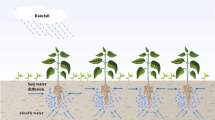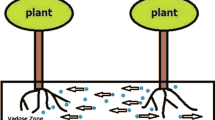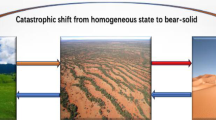Abstract
In this paper, we study a three-dimensional stochastic vegetation–water model in arid ecosystems, where the soil water and the surface water are considered. First, for the deterministic model, the possible equilibria and the related local asymptotic stability are studied. Then, for the stochastic model, by constructing some suitable stochastic Lyapunov functions, we establish sufficient conditions for the existence and uniqueness of an ergodic stationary distribution \(\varpi (\cdot )\). In a biological interpretation, the existence of the distribution \(\varpi (\cdot )\) implies the long-term persistence of vegetation under certain conditions. Taking the stochasticity into account, a quasi-positive equilibrium \(\overline{D}^*\) related to the vegetation-positive equilibrium of the deterministic model is defined. By solving the relevant Fokker–Planck equation, we obtain the approximate expression of the distribution \(\varpi (\cdot )\) around the equilibrium \(\overline{D}^*\). In addition, we obtain sufficient condition \(\mathscr {R}_0^E<1\) for vegetation extinction. For practical application, we further estimate the probability of vegetation extinction at a given time. Finally, based on some actual vegetation data from Wuwei in China and Sahel, some numerical simulations are provided to verify our theoretical results and study the impact of stochastic noise on vegetation dynamics.















Similar content being viewed by others
Data Availability
The data that support the findings of this study are available from the corresponding author upon reasonable request.
References
Beddington, J.R., May, R.M.: Harvesting natural populations in a randomly fluctuating environment. Science 197(4302), 463–465 (1977)
Cai, Y., Kang, Y., Wang, W.: A stochastic SIRS epidemic model with nonlinear incidence rate. Appl. Math. Comput. 305, 221–240 (2017)
Chen, Z., Wua, Y., Feng, G., Qian, Z., Sun, G.: Effects of global warming on pattern dynamics of vegetation: Wuwei in China as a case. Appl. Math. Comput. 390, 125666 (2021)
Cox, P.M., Betts, R.A., Jones, C.D., et al.: Acceleration of global warming due to carbon-cycle feedbacks in a coupled climate model. Nature 408, 184–187 (2000)
Dai, A.: Increasing drought under global warming in observations and models. Nat. Clim. Change 3(1), 52–58 (2013)
Gao, M., Jiang, D., Hayat, T., Alsaedi, A.: Stationary distribution and extinction for a food chain chemostat model with random peturbation. Math. Meth. Appl. Sci. 44, 1013–1028 (2021)
Gard, T.C.: Introduction to Stochastic Differential Equations. Marcel Dekker INC, New York (1988)
Gardiner, C.W.: Handbook of Stochastic Methods for Physics, Chemistry and the Natural Sciences. Springer, Berlin (1983)
Gilad, E., von Hardenberg, J., Provenzale, A., et al.: A mathematical model of plants as ecosystems engineers. J. Theor. Biol. 244, 680–691 (2007)
Guttal, V., Jayaprakash, C.: Impact of noise on bistable ecological systems. Ecol. Model. 201, 420–8 (2007)
Guttal, V., Jayaprakash, C.: Changing skewness: an early warning signal of regime shifts in ecosystems. Ecol. Lett. 11, 450–60 (2008)
Han, Q., Yang, T., Zeng, C., et al.: Impact of time delays on stochastic resonance in an ecological system describing vegetation. Phys. A 408, 96–105 (2014)
Han, B., Jiang, D., Hayat, T., et al.: Stationary distribution and extinction of a stochastic staged progression AIDS model with staged treatment and second-order perturbation. Chaos Soliton Fract. 140, 110238 (2020)
Han, B., Jiang, D., Zhou, B., et al.: Stationary distribution and probability density function of a stochastic SIRSI epidemic model with saturation incidence rate and logistic growth. Chaos Soliton Fract. 142(5), 110519 (2020)
Hautier, Y., Tilman, D., Isbell, F., et al.: Anthropogenic environmental changes affect ecosystem stability via biodiversity. Science 348(6232), 336–340 (2015)
Higham, D.J.: An algorithmic introduction to numerical simulation of stochastic differential equations. SIAM Rev. 43, 525–546 (2001)
Huang, J., Ji, M., Xie, Y., et al.: Global semi-arid climate change over last 60 years. Clim. Dyn. 46, 1131–1150 (2016)
Ikeda, N., Watanade, S.: A comparison theorem for solutions of stochastic differential equations and its applications. Osaka J. Math. 14, 619–633 (1977)
Imhof, L., Walcher, S.: Exclusion and persistence in deterministic and stochastic chemostat models. J. Differ. Equ. 217, 26–53 (2005)
Jordan, R., Kinderlehrer, D., Otto, F.: The variational formulation of the Fokker–Planck equation. SIAM J. Math. Anal. 29(1), 1–17 (1998)
Kefi, S., Rietkerka, M., Katul, G.G.: Vegetation pattern shift as a result of rising atmospheric \(\text{ CO}_2\) in arid ecosystems. Theor. Popu. Biol. 74, 332–344 (2008)
Kefi, S., Eppinga, M.B., de Ruiter, P.C., Rietkerk, M.: Bistability and regular spatial patterns in arid ecosystems. Theor. Ecol. 3, 257–269 (2010)
Khasminskii, R.: Stochastic Stability of Differential Equations. Springer, Berlin (2011)
Li, X., Liu, X., Ma, Z.: Analysis on the drought characteristics in the main arid regions in the world since recent hundred-odd years. Arid Zone Res. 21, 97–103 (2004)
Lin, Y., Jiang, D.: Threshold behavior in a stochastic SIS epidemic model with standard incidence. J. Dyn. Differ. Equ. 26(4), 1079–1094 (2014)
Lipster, R.: A strong law of large numbers for local martingales. Stochastics 3, 217–228 (1980)
Liu, Q., Jiang, D.: Periodic solution and stationary distribution of stochastic predator-prey models with higher-order perturbation. J. Nonlinear Sci. 28, 423–442 (2018)
Liu, Q., Jiang, D., Hayat, T., et al.: Dynamics of a stochastic predator-prey model with stage structure for predator and Holling Type II functional response. J. Nonlinear Sci. 28, 1151–1187 (2018)
Liu, C., Li, L., Wang, Z., Wang, R.: Pattern transitions in a vegetation system with cross-diffusion. Appl. Math. Comput. 342, 255–262 (2019)
Liu, Q., Jiang, D., Hayat, T., et al.: Stationary distribution and extinction of a stochastic HIV-1 infection model with distributed delay and logistic growth. J. Nonlinear. Sci. 30(1), 369–395 (2020)
Liu, G., Qi, H., Chang, Z., Meng, X.: Asymptotic stability of a stochastic May mutualism system. Comput. Math. Appl. 79(3), 735–745 (2020)
London, N., Unep, N.: United nations convention to combat desertification in countries experiencing serious drought and/or desertification, particularly in Africa. Document A/AC. 241/27, 12. 09. 1994 with Annexes, New York, NY (1994)
Ma, Z., Zhou, Y., Li, C.: Qualitative and Stability Methods for Ordinary Differential Equations. Science Press, Beijing (2015). (in Chinese)
Mao, X.: Stochastic Differential Equations and Applications. Horwood Publishing, Chichester (1997)
Marinov, K., Wang, T., Yang, Y.: On a vegetation pattern formation model governed by a nonlinear parabolic system. Nonlinear Anal. Real World Appl. 14, 507–525 (2013)
May, R.M.: Thresholds and breakpoints in ecosystems with a multiplicity of stable states. Nature 269(5628), 471–477 (1977)
Nguyen, D.H., Yin, G., Zhu, C.: Long-term analysis of a stochastic SIRS model with general incidence rates. SIAM J. Appl. Math. 80, 814–838 (2020)
Pan, S., Zhang, Q., Anke, M.: Near-optimal control of a stochastic vegetation–water system with reaction diffusion. Math. Meth. Appl. Sci. 43(9), 6043–6061 (2020)
Pan, S., Zhang, Q., Anke, M.: Stationary distribution of a stochastic vegetation–water system with reaction–diffusion. Appl. Math. Lett. 123, 107589 (2022)
Roozen, H.: An asymptotic solution to a two-dimensional exit problem arising in population dynamics. SIAM J. Appl. Math. 49, 1793 (1989)
Saco, P.M., Willgoose, G.R., Hancock, G.R.: Eco-geomorphology of banded vegetation patterns in arid and semi-arid regions. Hydrol. Earth Syst. Sci. 11, 1717–1730 (2007)
Shnerb, N.M., Sarah, P., Lavee, H., Solomon, S.: Reactive glass and vegetation patterns. Phys. Rev. Lett. 90(3), 038101 (2003)
Sun, G., Li, L., Zhang, Z.: Spatial dynamics of a vegetation model in an arid flat environment. Nonlinear Dyn. 73(4), 2207–2219 (2013)
Wang, F., Wang, X., Zhang, S., Ding, C.: On pulse vaccine strategy in a periodic stochastic SIR epidemic model. Chaos Soliton Fract. 66, 127–135 (2014)
Yang, D., Liu, Y., Cai, Z., et al.: The spatial and temporal distribution of carbon dioxide over China based on GOSAT observations. Chin. J. Atmos. Sci. 40(3), 541–550 (2016)
Zhang, X., Yuan, R.: A stochastic chemostat model with mean-reverting Ornstein–Uhlenbeck process and Monod–Haldane response function. Appl. Math. Comput. 394, 125833 (2021)
Zhang, H., Zhang, T.: The stationary distribution of a microorganism flocculation model with stochastic perturbation. Appl. Math. Lett. 103, 106217 (2020)
Zhang, H., Xu, W., Lei, Y., Qiao, Y.: Early warning and basin stability in a stochastic vegetation–water dynamical system. Commun. Nonlinear. Sci. Numer. Simul. 77, 258–270 (2019)
Zhang, H., Liu, X., Xu, W.: Threshold dynamics and pulse control of a stochastic ecosystem with switching parameters. J. Frankl. Inst. 358(1), 516–532 (2020)
Zhang, H., Xu, W., Han, P., Qiao, Y.: Stochastic dynamic balance of a bi-stable vegetation model with pulse control. Phys. A 556, 124809 (2020)
Zhang, H., Xu, W., Guo, Q., et al.: First escape probability and mean first exit time for a time-delayed ecosystem driven by non-Gaussian colored noise. Chaos Soliton Fract. 135, 109767 (2020)
Zhao, Y., Yuan, S., Ma, J.: Survival and stationary distribution analysis of a stochastic competitive model of three species in a polluted environment. Bull. Math. Biol. 77(7), 1285–1326 (2015)
Zhou, B., Jiang, D., Dai, Y., et al.: Stationary distribution and probability density function of a stochastic SVIS epidemic model with standard incidence and vacinnation. Chaos Soliton Fract. 143, 110601 (2021)
Zhou, B., Han, B., Jiang, D., et al.: Ergodic stationary distribution and extinction of a hybrid stochastic SEQIHR epidemic model with media coverage, quarantine strategies and pre-existing immunity under discrete Markov switching. Appl. Math. Comput. 410, 126388 (2021)
Zhu, C., Yin, G.: Asymptotic properties of hybrid diffusion systems. SIAM J. Control. Optim. 46, 1155–1179 (2007)
Zu, L., Jiang, D., O’Regan, D., et al.: Ergodic property of a Lotka–Volterra predator-prey model with white noise higher order perturbation under regime switching. Appl. Math. Comput. 330, 93–102 (2018)
Acknowledgements
This work is supported by the National Natural Science Foundation of China (No. 11871473) and Shandong Provincial Natural Science Foundation (No. ZR2019MA010, ZR2019MA006).
Author information
Authors and Affiliations
Ethics declarations
Conflict of interest
The authors declare that they have no conflict of interest.
Additional information
Communicated by Philipp M Altrock.
Publisher's Note
Springer Nature remains neutral with regard to jurisdictional claims in published maps and institutional affiliations.
Appendix A. (Local stability of system (1.1))
Appendix A. (Local stability of system (1.1))
In this section, we will focus on the local stability of the equilibria \(D_0\) and \(D^*\) of system (1.1).
Theorem A.1
If \({\mathscr {R}}_0<1\), the vegetation-free equilibrium \(D_0\) of system (1.1) is locally asymptotically stable (LAS), but it is unstable when \({\mathscr {R}}_0>1\).
Proof
The Jacobi matrix of system (1.1) at the equilibrium \(D_0\) is
By direct calculation, the characteristic polynomial of \(D_0\) is
Clearly, \(J(D_0)\) has three real eigenvalues \(y_1=R_\mathrm{esp}({\mathscr {R}}_0-1)\), \(y_2=-r_w<0\) and \(y_3=-\alpha w_0<0\). If \({\mathscr {R}}_0<1\), then \(J(D_0)\in {\overline{RH}}(3)\). Combining Definition 2.1 and the Routh–Hurwitz criterion (Ma et al. 2015), we obtain that \(E_0\) is LAS when \({\mathscr {R}}_0<1\). Conversely, if \({\mathscr {R}}_0>1\), we get that \(y_1=R_\mathrm{esp}({\mathscr {R}}_0-1)>0\), implying that \(D_0\) is unstable. This completes the proof of Theorem A.1. \(\square \)
Next, we define a critical value by
Theorem A.2
If \({\mathscr {R}}_0>1\) and \({\mathscr {R}}_1\ge 0\), the vegetation-positive equilibrium \(D^*\) is LAS.
Proof
Similar to Theorem A.1, the Jacobi matrix of system (1.1) at the equilibrium \(D^*\) is
where \(a_{12}=\frac{c\alpha _2g_{\mathrm{co}_2}k_1P^*}{(W^*+k_1)^2}>0\), \(a_{21}=\frac{\alpha k_2(1-w_0)S^*}{(P^*+k_2)^2}-\frac{q\alpha _2\gamma g_{\mathrm{co}_2}W^*}{W^*+k_1}\), \(a_{22}=\frac{q\alpha _2\gamma g_{\mathrm{co}_2}k_1P^*}{(W^*+k_1)^2}+r_w>0\), \(a_{23}=\frac{\alpha (P^*+k_2w_0)}{P^*+k_2}>0\) and \(a_{31}=\frac{\alpha k_2(1-w_0)S^*}{(P^*+k_2)^2}>0\). A direct calculation shows that
where \(l_1=a_{22}+a_{23}>0\), \(l_2=a_{22}a_{23}-a_{12}a_{21}\) and \(l_3=a_{12}a_{23}(a_{31}-a_{21})\).
If \({\mathscr {R}}_0>1\), we determine that \(P^*=\frac{c(R+r_\mathrm{w}k_1)({\mathscr {R}}_0-1)}{q\gamma (c\alpha _2g_{\mathrm{co}_2}-R_\mathrm{esp})}\) and \(a_{31}-a_{21}=\frac{q\alpha _2\gamma g_{\mathrm{co}_2}W^*}{W^*+k_1}>0\), which means that \(l_3>0\). Moreover, if \({\mathscr {R}}_1\ge 0\), by the equality \(R=\frac{\alpha (P^*+k_2w_0)S^*}{P^*+k_2}\), we have
Combined with \(a_{21}<a_{31}\), we obtain that \(l_2=a_{22}a_{23}-a_{12}a_{21}>a_{22}a_{23}-a_{12}a_{31}\ge 0\) and
According to the Routh–Hurwitz criterion, we determine that \(J(D^*)\in {\overline{RH}}(3)\). Thus, \(D^*\) is LAS when \({\mathscr {R}}_0>1\) and \({\mathscr {R}}_1\ge 0\). This completes the proof of Theorem A.2. \(\square \)
Rights and permissions
About this article
Cite this article
Zhou, B., Han, B., Jiang, D. et al. Stationary Distribution, Extinction and Probability Density Function of a Stochastic Vegetation–Water Model in Arid Ecosystems. J Nonlinear Sci 32, 30 (2022). https://doi.org/10.1007/s00332-022-09789-7
Received:
Accepted:
Published:
DOI: https://doi.org/10.1007/s00332-022-09789-7
Keywords
- Stochastic vegetation–water model
- Climatic variations
- Stationary distribution
- Ergodicity
- Probability density function
- Extinction




